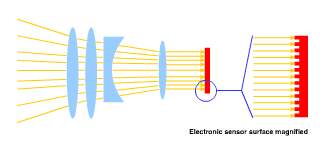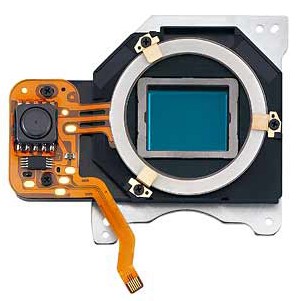Concepts and overview
2003: The birth of a new Olympus SLR System
In 2002, the same year in which the Olympus OM
manual focus, film-based SLR system was terminated, a whole new system and
lens mount standard was announced:
the digital E-System, based on the open "Four Thirds" lens mount
standard. It came on the market in 2003, featuring the E-1 camera body, and a
relatively small (at least compared to the OM System) set of lenses and
accessories. In between Olympus didn't have any SLR system. It had Point
& Shoot Cameras and a
couple of Zoom Lens Reflex (ZLR) Cameras: the film-based iS-5000 and iS-500 (see
the iS/L Series Page for the ZLR
concept), and the digital Camedia E-10, E-20(N) and E-100RS.
These last three models were, despite their "E" names, not part of the E-System.
First, E-System camera bodies don't carry the Camedia designation.
Second, ZLR
cameras have a built-on non-exchangeable lens and therefore can't be true System
Cameras. The Camedia E-10 (introduced in 2000) and Camedia E-20(N) (introduced in 2001) were reflex cameras, with an optical Through The
Lens (TTL) viewfinder; the Camedia E-100RS had an electronic viewfinder. The E-10 and E-20(N) could be considered as
predecessors of the E-System - they supported the external FL-20 and FL-40 flashes which
are compatible with the E-System bodies; vice versa the new FL-36 and FL-50 flashes can be used on these
cameras.
One might wonder why Olympus terminated the OM System and created a whole new
system and lens standard. Would it not have been easier to make a digital AF OM-mount
compatible body and reintroduce some of the AF lenses for the only AF OM body
Olympus ever made, the OM-707 AF? After all,
Nikon and Canon did the same - they kept the existing analogue lens mount
standards and built digital bodies for them. The answer from Olympus was that
lenses designed for film based photography are not optimized for digital
photography. When a lens designed for analogue photography is used, light falls
onto the sensor under an angle, which reduces sharpness, especially in the
corners, especially for wide angle lenses.
Four Thirds
The Four Thirds lens standard was designed by Olympus and Kodak as an open
standard, meaning that any company may adapt it and create bodies or
lenses for it. The standard describes the mount size, sensor size,
mount-to-sensor distance and electronic
communications between lens and camera. The idea alone of an open standard lens
mount is revolutionary - until then every SLR camera manufacturer had its own
standard.
The term Four Thirds comes way back from the 1950's when it
described the outside diameter of vacuum valves for video recording, called
Vidicon. This was four / thirds of an inch (33.87 mm); this is also the
outside diameter of the Kodak sensor KAF-5101CE featured in the E-1. The
rectangular sensor has an inner diagonal of 22.3 mm, measuring 18 x 13.5 mm.
This diagonal is roughly the half of 35 mm film (dimensions 36 x 24mm,
diagonal 43.3 mm).
![]()
This size means that focal lengths for Four Thirds lenses are
also the half of the 35 mm lenses.
This, in combination with the relatively large diameter of the lens mount, makes
it possible to design fast lenses that are much smaller and lighter as
corresponding 35mm film lenses, and even to design lenses that are faster than
35mm film lens design would allow. A 300mm/F2 lens, 600mm/F2.8 lens or 2.5-3x zoom lenses as
bright as F2 are examples of this; such lenses would be impossible to design for
35mm (or else they would be huge, heavy and extremely expensive) - they do
exist in the E-System!
Compare, for instance, the digital Zuiko ED 150mm/F2 (corresponding to
300mm/F2 for 35mm film) to the longest F2 lens ever made for 35mm, the Zuiko
250mm/F2 for the OM System. The first has a length of 150mm and weighs only
1610g. The latter had a length of 246mm and weighted 3900g! And its focal length
was shorter too. There's also an interesting difference in price: the first
costs 2000 Euros, the latter cost in 2001 13.450 Euros...
Telecentric design
All digital Zuiko lenses feature a telecentric design. This means that light
strikes the sensor at a right angle for all focal lengths. This improves image
quality since photo sensors can't handle light that hit them under an angle
other than 90 degree very well. This is especially the case when wide angle
lenses designed for 35mm photography are mounted on a digital camera. Blurring
and shading may occur with such lenses.

Supersonic Dust Filter
Another novelty that was introduced in the E-System was the Supersonic Dust
Filter - placed between the shutter and the sensor, it is activated when
the camera is turned on. It vibrates a high speed and removes any dust from the
sensor. Dust is a major problem with digital SLR cameras, since it's difficult
to avoid when changing lenses in rough conditions, difficult to remove by the
user and can have serious impact on image quality.

page under construction; last update: september 24, 2005